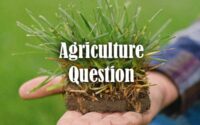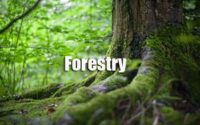Soil Science MCQ
1. The following watershed gives highest peak discharge for the same area –
(1) Fern shaped
(2) Fan shaped
(3) Square shaped
(4) Rectangular shaped
2. The time required to move the water from remotest point of watershed to the outlet is called as –
(1) unit duration
(2) run-off duration
(3) time of concentration
(4) effective rainfall
3. For any watershed the values of sediment delivery ratio is always –
(1) more than 1
(2) 1
(3) less than 1
(4) 2.5
4. Side slope of medium gullies varies from –
(1) 8 to 15%
(2) 2 to 3%
(3) 5 to 7%
(4) 3 to 6%
5. The shape of the watershed is generally expressed by –
(1) Form factor
(2) Basin shape factor
(3) Drainage density
(4) Elongation ratio
6. Which of the following set of crops contains C4 plants ?
(1) Cotton, rice and wheat
(2) Pearlmillet, rice and soyabean
(3) Maize, pearlmillet and sorghum
(4) Peanut, rice and wheat
7. When two or more crops are grown simultaneously but do not have inter-competition effects are called –
(1) turf crops
(2) companion crops
(3) brake crops
(4) parallel crops
8. The germination, in which the plumule ts pushed upward and the cotyledon remains inside the soil is called :
(1) Epigeal germination
(2) Negative germination
(3) Hypogeal germination
(4) Induced germination
9. Restorative crops are those crops which –
(1) provide a good harvest along with amelioration of the soil.
(2) on growing leave the field exhausted.
(3) are able to protect the soil surface from erosion.
(4) are grown for temporary storing.
10. Growing of four crops per year in such a way that land is passed on to another crop before the previous one is harvested is called –
(1) inter cropping
(2) relay cropping
(3) ratoon cropping
(4) multi-storeyed cropping
11. If paddy followed by wheat or sorghum followed by gram is cultivated in a succession on a piece of land in an agricultural year is called –
(1) multiple cropping
(2) double cropping
(3) continuous cropping
(4) rotational cropping
12. Pop corn is –
(1) Zea mays indentata sturt
(2) Zea mays averta sturt
(3) Zea mays saccharata sturt
(4) Zea mays tunicata sturt
13. Which of the weed is controlled by the use of Zygogramima bicolerata as a bio-agent ?
(1) Prickly pear / Opuntia sp.
(2) Xanthiun strumarium
(3) Lantana camera
(4) Parthenium hysterophorus
14. Which of the following is an example of mimicry weed ?
(1) Green gram RMG-344 in green gram RMG-492 crop:
(2) Black gram in green gram crop
(3) Chenopodium murale in berseem crop
(4) Phalaris minor in wheat crop
15. Herbicide used to control ‘Orobanche aegyptiaca’ parasite in mustard crop is –
(1) pendemethalin and fluchloralin
(2) alachlor and bentazon
(3) mitrofen and trifluralin
(4) MSMA and DSMA
16. Which of the following is a spreading type groundnut variety ?
(1) A. K. 12-24
(2) R.G 141
(3) T.G37A
(4) RG 382
17. Most commonly used herbicide in groundnut fields to control both annual and broad leaved weeds is –
(1) Fluchloratin
(2) Atrazine
(3) Alachlor
(4) 2, 4-D
18. The scientific name of weed species — wild mustard is –
(1) Melochia corchorifolia
(2) Ovxalis corniculate
(3) Vicia sativa
(4) Cleoma viscosa
19. Which of the following is not the selective herbicides ?
(1) 2, 4-D
(2) Simazine
(3) Paraquat
(4) Butachlor
20. Which disease of pearlmillet contains toxic alkaloids harmful to health ?
(1) Rust
(2) Downy mildew
(3) Ergot
(4) Smut
| MCQs | Quiz |
| GK | Questions and Answers |
21. Inter and intra row spacing of black gram is maintained as –
(1) 25 cms and 10 cms
(2) 30 cms and 10 cms
(3) 40 cms and 10 cms
(4) 20 cms and 20 cms
22. In which of the following crop, nipping is done to stop the apical growth and promote the lateral branchings ?
(1) Pearlmillet
(2) Green gram
(3) Bengal gram
(4) Mustard
23. Which of the following state stands first in area and production of Bengal gram (chick pea) ?
(1) Madhya Pradesh (M.P.)
(2) Maharashtra
(3) Rajasthan
(4) Uttar Pradesh (U.P)
24. Minimum per capita pulses recommended by ICAR is –
(1) 20 gram
(2) 40 gram
(3) 70 gram
(4) 120 gram
25. When the seeds of pearlmillet and green gram are mixed and sown by broadcasting method is an example of :
(1) rotational cropping
(2) continuous cropping
(3) mixed cropping
(4) sequential cropping
26. Growing only one crop year after year on a piece of land is called –
(1) Sole cropping
(2) Cropping pattern
(3) Companion cropping
(4) Mono-cropping
27. In which of the following – critical growth stages, the wheat crop should be irrigated, if water is available only for two irrigations ?
(1) Crown root initiation (CRI) + dough
(2) Late tillering and flowering
(3) Crown root initiation (CRI) + milking
(4) Late jointing and flowering
28. Maximum number of fruit plants can be planted in the orchard by the system –
(1) Square
(2) Triangular
(3) Hexagonal
(4) Rectangular
29. Which is known as “Teak of Rajasthan” ?
(1) Siris
(2) Rohida
(3) Arjun
(4) Neem
30. Which one of the following is not an arid fruit ?
(1) Pomegranate
(2) Grape
(3) Bael
(4) Aonla
31. Best soil for planting a fruit orchard should have pH between :
(1) 3.5 – 5.5
(2) 4.5-6.5
(3) 6.5-7.5
(4) 7.5-8.5
32. A fruit called “Indian goosberry” is :
(1) Guava
(2) Aonla
(3) Ber
(4) Pomegranate
33. Central Institute for Arid-Horticulture is situated at :
(1) Bangalore
(2) Buyapur
(3) Bikaner
(4) Bhopal
34. High production in protective cultivation is due to –
(1) High temperature
(2) High O2
(3) High photosynthetic efficiency
(4) All of the above
35. Biennial Bearing is one of the most serious problem in –
(1) Mango
(2) Datepalm
(3) Banana
(4) Ber
36. Leucacena leucecephala is the botanical name of :
(1) Khejri
(2) Israeli babool
(3) Soobabool
(4) Ardu
37. Which of the following fruit crop have varieties ‘Chitidar’ and ‘Lucknow-49″ ?
(1) Pomegranate
(2) Aonla
(3) Guava
(4) Mango
38. Mridula is a cultivar of –
(1) Guava
(2) Ber
(3) Pomegranate
(4) Aonla
39. Seedless variety of mango is
(1) Amrapali
(2) Langra
(3) Stndhu
(4) Dashehart
40. Best time of budding in ber is :
(1) July-August
(2) September-October
(3) November-December
(4) May-June
41. In grafting lower part of plant is known as :
(1) Stock
(2) Apical
(3) Bud
(4) Scion
42. Ber is commercially propagated by –
(1) Inarching
(2) Layering
(3) Seeds
(4) T-budding
43. Commercial method of propagation in mango is –
(1) Vineer grafting
(2) Seed
(3) Budding
(4) Cutting
44. Management of forest through peoples participation is called :
(1) Social forestry
(2) Farm forestry
(3) Agro-forestry
(4) Joint forest management
45. Fruit cracking in pomegranate is due to deficiency, of :
(1) Nitrogen
(2) Zine
(3) Boron
(4) Copper
46. Fruitfly is a major pest of :
(1) Aonla
(2) Pomegranate
(3) Mango
(4) Ber
47. Richest source of “Vitamin C” is :
(1) Pomegranate
(2) Guava
(3) Bael
(4) Aonla


